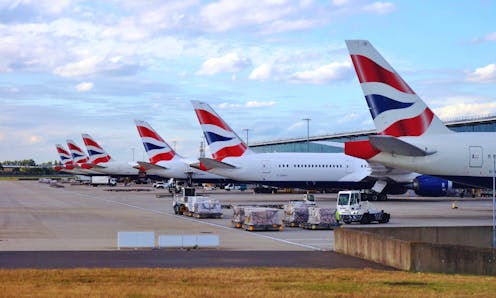how airlines manage crises like the Heathrow shutdown
- Written by Guglielmo Lulli, Professor in Network Analytics, Lancaster University

In 2024, Heathrow was the busiest airport in Europe[1] by passenger numbers and the fourth busiest worldwide. Nearly 84 million[2] passengers passed through its five terminals during the year. These figures highlight the scale of disruption caused by its recent complete closure after a fire[3] at an electricity substation.
Airlines with just a limited number of flights to and from Heathrow are likely to have experienced only minimal disruption – something airlines face regularly as part of standard operations. But the impact on airlines that use Heathrow as a main hub will turn out to be severe. For these airlines[4], which operate on very slim margins, the associated costs can be so high that they may wipe out several months’ worth of profits.
And this is something airline bosses will have been painfully aware of when news broke of the closure. Their first consideration, however, will have been for safety.
From an operational perspective, the primary objective in a situation like this is to ensure that all flights already in the air can safely complete their journey, either by landing at an alternate airport or returning to their departure airport.
The decision depends on a flight’s position and the amount of fuel the aircraft has left on board. As part of standard procedure all flights have a designated alternate airport – usually chosen based on proximity.
However, in the specific Heathrow case, the sheer volume of diversions quickly saturated the UK’s diversion capacity, forcing many flights to reroute to airports overseas.
This challenge was compounded by the nature of Heathrow’s traffic. As a major hub for long-haul flights operated by wide-body aircraft, these planes can only be diverted to large airports capable of handling their size and requirements. For instance, Heathrow is one of the main hubs for the Airbus A380[5], the largest passenger aircraft in the world. Due to its size, it can operate at only a limited number[6] of airports.
Although the Heathrow closure came out of the blue, airlines do of course have emergency plans setting out guidelines and procedures for various types of crises, which are regularly updated. Each airline has its own operations control centre, usually within its headquarters, which is responsible for activating and overseeing these plans.
But in the case of a major crisis or disruptive event, such as when a hub like Heathrow shuts down, the company’s top management along with the heads of its operational departments will hold emergency meetings to enable rapid and effective decision-making.
Airlines also have dedicated crisis rooms for this purpose. Throughout the crisis, the situation is continuously monitored and decisions are focused on minimising both operational and financial impact.
Of course, when a disruption of the magnitude of the Heathrow shutdown occurs, the entire airline schedule is thrown into disarray.
Planning and scheduling airline operations is a complex, lengthy process that begins up to two months before the day of the flight. It involves numerous operational aspects, including aircraft assignment, crew scheduling and maintenance.
And for legacy air carriers, this process is complicated by the nature of their operations within a global network of often complex connected journeys. These airlines operate a diverse fleet of aircraft with hundreds of connecting flights.
Pilots are qualified to fly only specific aircraft types, and passengers often travel to a hub such as Heathrow to continue their journey to their final destination. These operations are incredibly intricate, so in the event of a major disruption it becomes necessary to restart the process from scratch. This often leads to numerous flight cancellations.
Given the high costs involved – including expenses for passenger rebooking and accommodation – each flight must be analysed individually to determine the most appropriate course of action.
The Heathrow shutdown left hundreds of thousands of passengers[8] stranded or unable to travel. It is a legal[9] priority for the airline to offer them alternative options to reach their destination. Typically, passengers can be rebooked on flights operated by either the same airline or other carriers, or offered hotel accommodation until the next available flight.
As a “force majeure”[10] incident, airlines are not likely to be liable to pay compensation[11] to passengers in the Heathrow case. But all the other costs quickly mount up for airlines – explaining the expected hit to their profits[12].
In the end, Heathrow was up and running[13] at full capacity again far quicker than many observers anticipated. But a shutdown at such a major global transport hub will leave airlines – and other businesses – counting the costs for some time to come.
References
- ^ busiest airport in Europe (www.oag.com)
- ^ 84 million (www.bbc.co.uk)
- ^ fire (theconversation.com)
- ^ airlines (www.yahoo.com)
- ^ Airbus A380 (www.airbus.com)
- ^ limited number (simpleflying.com)
- ^ EPA-EFE/TOLGA AKMEN (epaimages.com)
- ^ hundreds of thousands of passengers (www.theguardian.com)
- ^ legal (www.caa.co.uk)
- ^ “force majeure” (www.investopedia.com)
- ^ liable to pay compensation (news.sky.com)
- ^ hit to their profits (news.sky.com)
- ^ up and running (www.stattimes.com)







